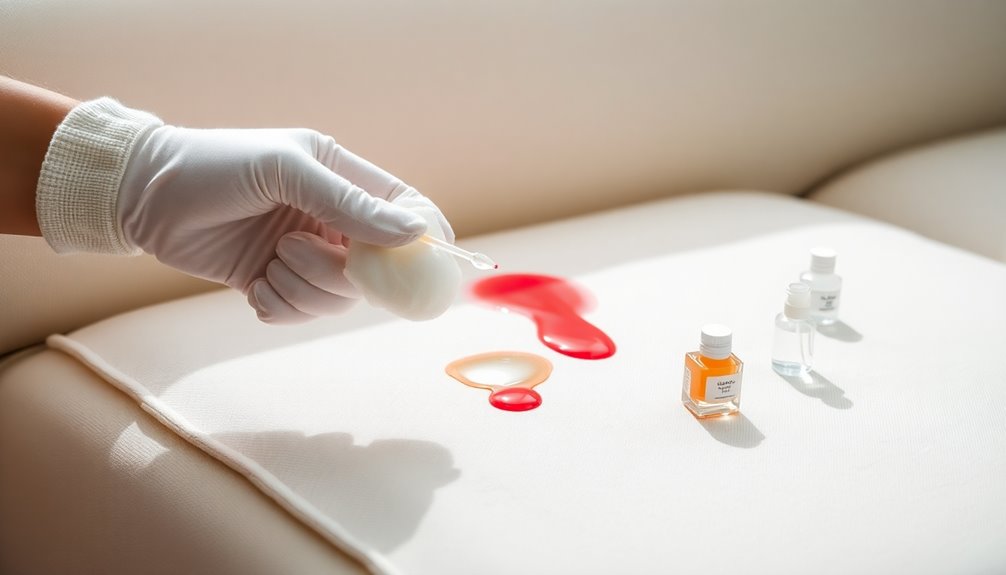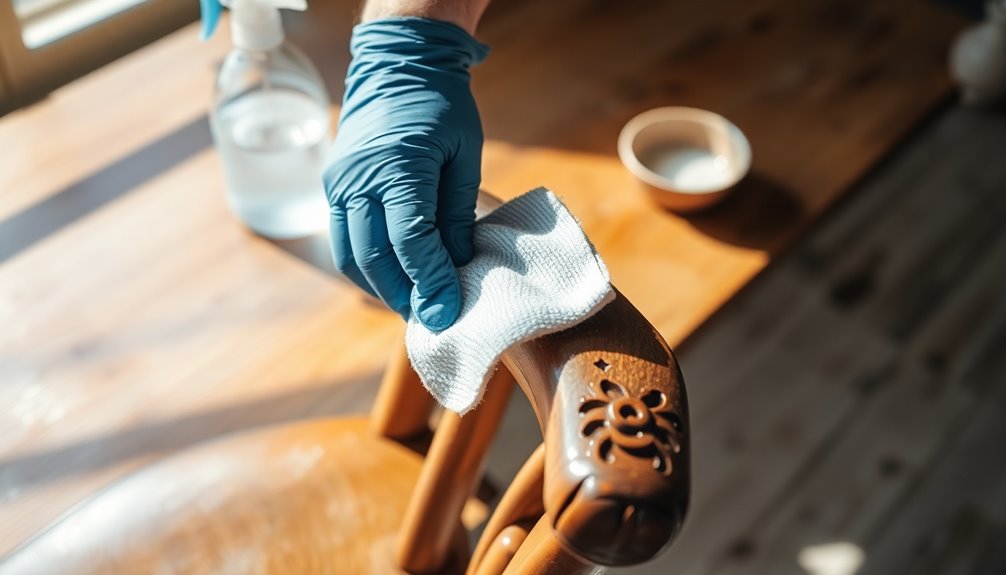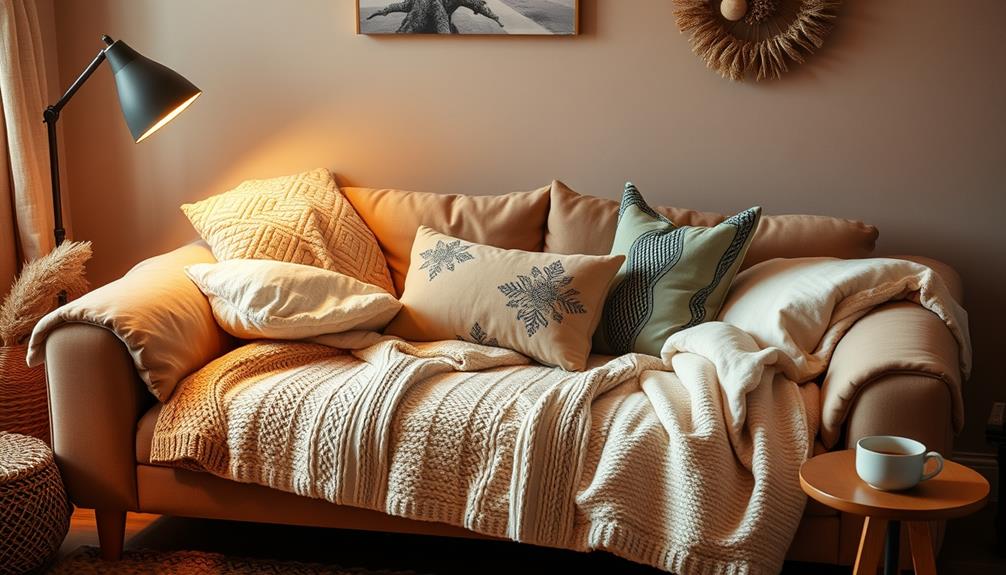To remove nail polish from your sofa, act quickly. Start by gently blotting the stain with a clean cloth or paper towel to absorb excess polish. For most fabrics, mix a bit of liquid dish soap with cool water and apply it to the stain, then rinse with a damp cloth. If the stain persists, you can use non-acetone nail polish remover on a cotton ball, but do a spot test first to check for colorfastness. Always blot from the outer edge inward to prevent spreading. There's more to mastering upholstery care, so keep exploring!
Key Takeaways
- Blot the nail polish stain immediately with a clean cloth to absorb excess liquid and prevent deeper penetration.
- Mix liquid dish soap with cool water and gently apply it to the stained area for initial treatment.
- Rinse the soap residue with a damp cloth once the stain starts to lift, avoiding rubbing.
- For persistent stains, use non-acetone nail polish remover on a cotton ball, blotting gently from the outer edges.
- Always conduct a spot test on a hidden area of the fabric to check for colorfastness before applying any cleaning solution.
Introduction
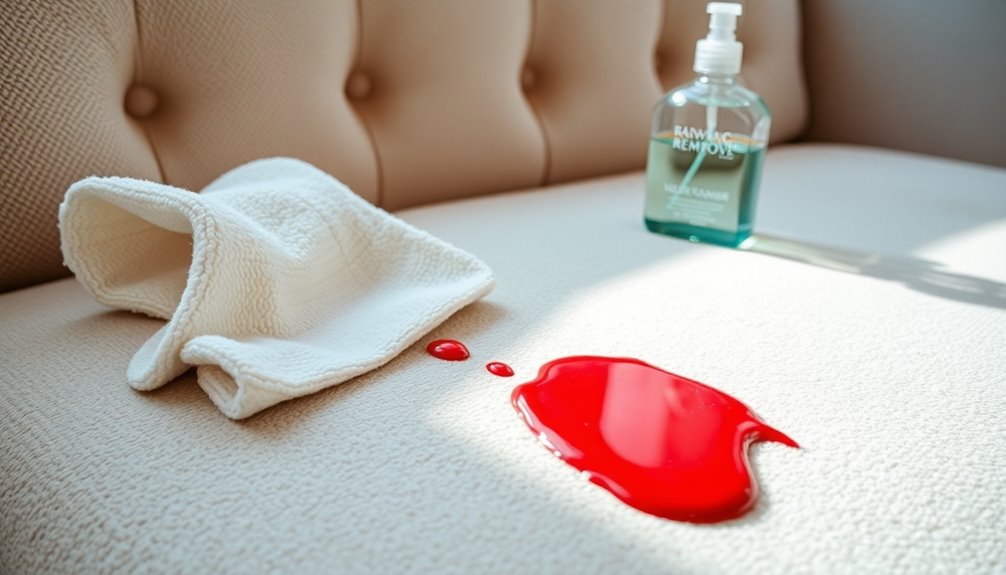
When it comes to maintaining your sofa, routine upholstery care is essential. You'll want to know fabric-specific cleaning techniques to keep it looking its best, especially when accidents happen, like nail polish spills. Let's explore how to tackle those pesky stains effectively.
Routine Upholstery Care Tips
Maintaining your sofa's appearance requires consistent care, and incorporating simple routines can make a big difference. Start by regularly vacuuming your sofa to remove dust and debris that can contribute to staining and wear over time. Use a soft brush attachment to gently clean fabric surfaces without causing any damage.
When spills occur, it's crucial to act quickly. Blot the area with a clean cloth to absorb excess liquid and prevent it from penetrating deeper into the upholstery. Remember, the key is to blot, not rub, as rubbing can spread the stain and damage the fabric.
Before applying any cleaning solutions, always test them on an inconspicuous area to avoid discoloration. This precaution helps ensure that your cleaning method won't harm your sofa's fabric.
To maintain your upholstery's appearance and prolong its lifespan, schedule professional upholstery cleaning at least once a year. This thorough cleaning will remove built-up dirt and grime, keeping your sofa looking fresh and inviting. By following these routine care tips, you'll ensure your sofa remains a beautiful centerpiece in your home for years to come.
Fabric-Specific Cleaning Techniques
Understanding the specific cleaning techniques for different fabric types is essential for effectively removing stains without causing damage. For synthetic upholstery, use non-acetone nail polish remover applied to a cotton ball. Blot the stain gently to avoid spreading it further. For delicate fabrics like silk and wool, mix white vinegar or lemon juice with warm water. Apply this cleaning solution to the stain and let it sit for 20-30 minutes before you blot it away.
If your sofa features suede, create a paste using baking soda and water. Apply this paste to the stain and allow it to sit for 30 minutes to absorb the nail polish. Afterward, brush off the residue gently. Regardless of the fabric type, always conduct a spot test of any cleaning solution on an inconspicuous area first to check for colorfastness. Remember, it's crucial to avoid rubbing the stain; instead, use a blotting motion from the outer edge toward the center. This helps minimize damage and ensures a more effective cleaning process.
Tackling Nail Polish Stains
Nail polish stains on your sofa can be a frustrating sight, but quick action can save your upholstery from lasting damage. To effectively tackle the stain, you need to act quickly before it penetrates deeper into the fabric. Start by gently blotting the stained area with a clean cloth or paper towel. Avoid rubbing, as this can spread the polish further.
Next, mix a small amount of liquid dish soap with cool water. Dampen a clean cloth in this solution and apply it to the stain. Blot the area until the stain starts to lift, then rinse with a cloth dampened in plain water to remove any soap residue. Always conduct a spot test on an inconspicuous area first to ensure your fabric doesn't discolor.
If the stain persists, consider using non-acetone nail polish remover. Apply it to a cotton ball and blot the area gently, being careful not to rub. Remember to blot rather than rub, as this technique helps lift the stain without damaging the fabric. With these steps, you'll be well on your way to successfully removing nail polish from your sofa!
Avoiding Direct Sunlight Exposure
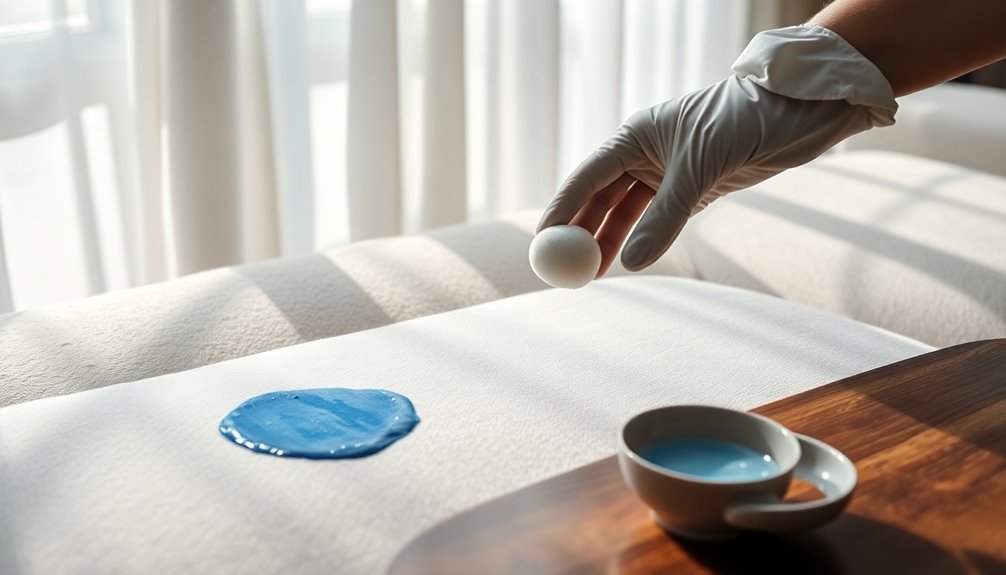
To protect your sofa from sun damage, consider scratch-resistant fabric options that can withstand fading. You can also explore protective layers and furniture covers designed to shield your upholstery from harmful UV rays. These strategies not only preserve your sofa's appearance but also extend its lifespan.
Scratch-Resistant Fabric Options
Choosing the right scratch-resistant fabric for your sofa is essential, especially if you want it to withstand daily wear and tear. Look for materials like microfiber or certain synthetic blends, which are designed to be durable and resist stains. These tightly woven fabrics can maintain their appearance even in high-traffic areas, making them perfect for your living space.
To ensure your sofa stays in top shape, regular cleaning and maintenance are crucial. Use a soft cloth and a mild cleaning solution to wipe away spills promptly, preventing stains from setting in. Remember, while scratch-resistant fabrics are tough, they can still fade when exposed to direct sunlight. Avoid placing your sofa in sunny spots to preserve its color and integrity.
When shopping, prioritize upholstery labeled as "high-performance" or "durable." This way, you'll know you're investing in a fabric that can handle the rigors of daily life. By making informed choices and practicing proper care, you can enjoy a stylish and resilient sofa that stays looking great for years to come. Additionally, consider fabrics that are also highly adaptable to various living environments, ensuring they can fit seamlessly into your home.
Protective Fabric Layers
Protecting your sofa from direct sunlight is crucial for maintaining its vibrant appearance and longevity. Sunlight can cause fading and deterioration of upholstery fibers over time, so investing in protective fabric layers is a smart move. Consider using slipcovers or throws made from UV-resistant materials. These not only shield your sofa from harmful rays but also add to its aesthetic appeal.
To further minimize exposure, regularly reposition your furniture. This practice helps avoid prolonged sunlight exposure on any one area, ensuring your sofa maintains a uniform look. Additionally, utilizing window treatments like curtains or blinds allows you to control the amount of sunlight reaching your sofa, significantly reducing the risk of discoloration.
Using Furniture Covers
After taking steps to shield your sofa from sunlight, consider using furniture covers for added protection against potential spills, like nail polish. These covers can effectively protect your sofa from stains before they even occur. When selecting covers, opt for breathable, washable materials that you can easily remove and cleaned after any accidents.
It's crucial to choose covers that offer UV protection, as this will shield your sofa from direct sunlight, preventing fabric fading and wear over time. Make sure the covers fit snugly to avoid slipping; you don't want any part of the underlying fabric exposed to spills.
Regularly inspect the covers to ensure they remain effective in protecting your sofa. This maintenance is vital, as wear and tear could diminish their protective capabilities. By being proactive and using furniture covers, you'll not only protect your sofa from unwanted stains but also preserve its appearance for years to come. So, go ahead and invest in quality furniture covers to keep your sofa looking fresh and new, while also saving you the hassle of dealing with nail polish spills in the future.
Upholstery Cleaning and Restoration

When tackling upholstery cleaning and restoration, you need to consider the integrity of the frame as well as the fabric. You can use various techniques to repair or renew your upholstery, ensuring it looks its best. Let's explore how to address common issues for long-lasting results.
Frame Integrity Concerns
Removing nail polish from your sofa can pose risks to its frame integrity if not done carefully. First, assess the upholstery fabric type to determine the safest cleaning method. Some materials are more prone to damage, which can affect both appearance and stability. Always avoid excessive force or scrubbing, as this can loosen joints and compromise the structure.
Before applying any cleaning solution, conduct a patch test on an inconspicuous area of the fabric. This step ensures that the cleaning method won't weaken the upholstery or cause discoloration, which could ultimately impact the frame integrity. If the stain is near seams or areas where the frame is exposed, consider using a specialized upholstery cleaner or consulting a professional. They can provide the safest options tailored to your specific fabric type.
Regular maintenance and cleaning of your upholstery not only help with stain removal but also prolong the lifespan of your sofa frame. By taking these precautions and being mindful of the frame integrity, you can effectively tackle nail polish stains without causing further damage to your beloved furniture.
Upholstery Fabric Repair Techniques
Upholstery fabric repair techniques are essential for maintaining your furniture's appearance and longevity. When tackling issues like removing nail polish or other stains, start by identifying the fabric type. This helps you choose the right cleaning solutions and tools, as each material requires specific care.
For minor stains, mix 1 tablespoon of liquid dish soap with 2 cups of cool water. Use a clean cloth to apply the detergent solution, blotting gently until the stain is absorbed. Avoid rubbing, as this can damage the fabric. If the stain persists, you may need to consider professional upholstery cleaning services that use steam cleaning methods and specialized solvents for deep-set stains.
In cases of significant damage, upholstery repair might be necessary. You can patch the area with matching fabric or use upholstery repair kits containing adhesive and fabric patches designed for your specific material. Regular maintenance, such as vacuuming and applying fabric protectors, can prevent future stains and extend the life of your upholstered furniture, reducing the need for extensive repairs. Additionally, using an air purifier can help improve indoor air quality by reducing allergens that may settle on your upholstery.
Upholstery Renewal Techniques
Renewing your upholstery can breathe new life into your furniture, making it look fresh and inviting. If you're dealing with a stain, like nail polish, it's crucial to act quickly. Start by using a clean cloth to blot the stain immediately, absorbing any excess polish before it spreads. Avoid rubbing, as that can worsen the issue.
Next, mix a solution of 1 tablespoon of liquid dish soap with 2 cups of cool water. Use a clean cloth to sponge the stained area, blotting until the stain starts to lift. If the stain persists, a non-acetone nail polish remover on a cotton ball can be effective. Gently apply it to the stain, then use a clean cloth to absorb the polish.
Always remember to test any cleaning solution on an inconspicuous area of the upholstery first. This ensures you won't cause discoloration or damage. For stubborn stains or delicate fabrics, don't hesitate to call in professional upholstery cleaning services. They can effectively remove stains while ensuring your furniture remains in pristine condition. Your upholstery deserves a renewal that keeps it looking its best!
Fabric Dye Treatments

Dealing with nail polish stains on your sofa can feel daunting, especially when considering the potential for fabric dye damage. The first step is to identify your fabric type, as different materials react differently to cleaning solutions. For synthetic or blended fabrics, you might find that non-acetone nail polish remover works well, but be careful not to oversaturate the area, which could lead to dye transfer.
If your sofa is made from natural fibers like cotton or linen, you'll want to take a gentler approach. Mix a small amount of mild dish soap with water and apply it to the stain, ensuring you're careful to avoid damaging the dye. Always perform a spot test on an inconspicuous area of the fabric before applying any cleaning solution. This step is crucial to ensure that the dye doesn't bleed or change color.
If you notice any dye transfer during the cleaning process, it might be time to call in professional cleaning services. They have the expertise to restore your fabric to its original condition without causing further damage.
Preventive Upholstery Maintenance Tips
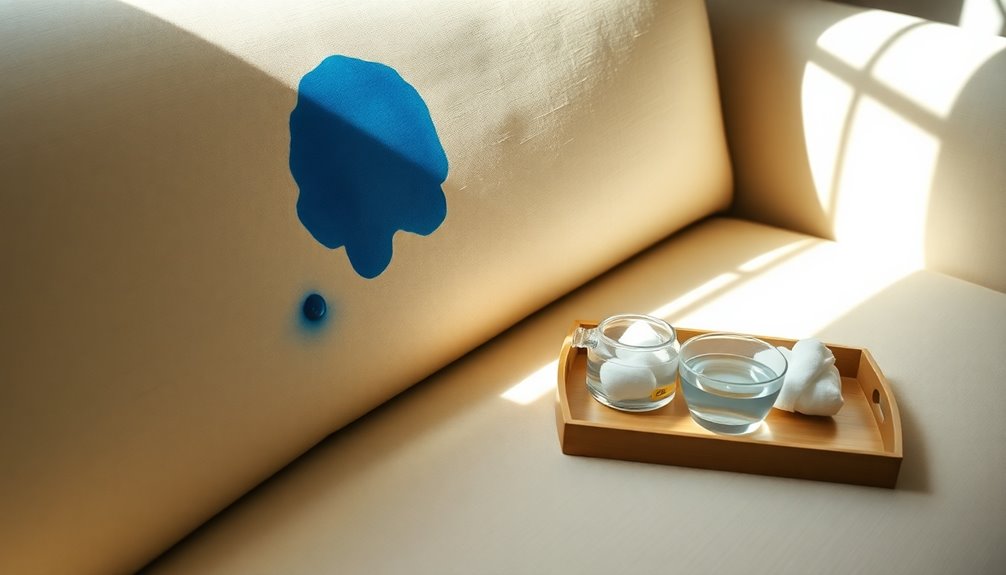
Maintaining your sofa's upholstery requires a few simple yet effective strategies to keep it looking fresh and inviting. Start by regularly vacuuming your upholstered furniture to remove dust and debris. This prevents dirt from settling into the fabric and makes future stains easier to clean.
Consider using fabric protectors designed specifically for upholstery; they create a barrier against spills and stains. Reapply these protectors every few months for maximum effectiveness. If a spill occurs, act quickly by blotting the area with a clean cloth. Avoid rubbing, as this can spread the stain further. Use appropriate cleaning solutions suited for your sofa's fabric type to tackle any stains that might set in.
To maintain an even appearance and prolong the life of your upholstery, rotate cushions regularly. This helps distribute wear and tear evenly. Finally, keep a cleaning kit handy that includes mild detergents and cloths suitable for your fabric. Being prepared allows for quick action against potential stains, ensuring your sofa remains a beautiful centerpiece in your home.
Conclusion
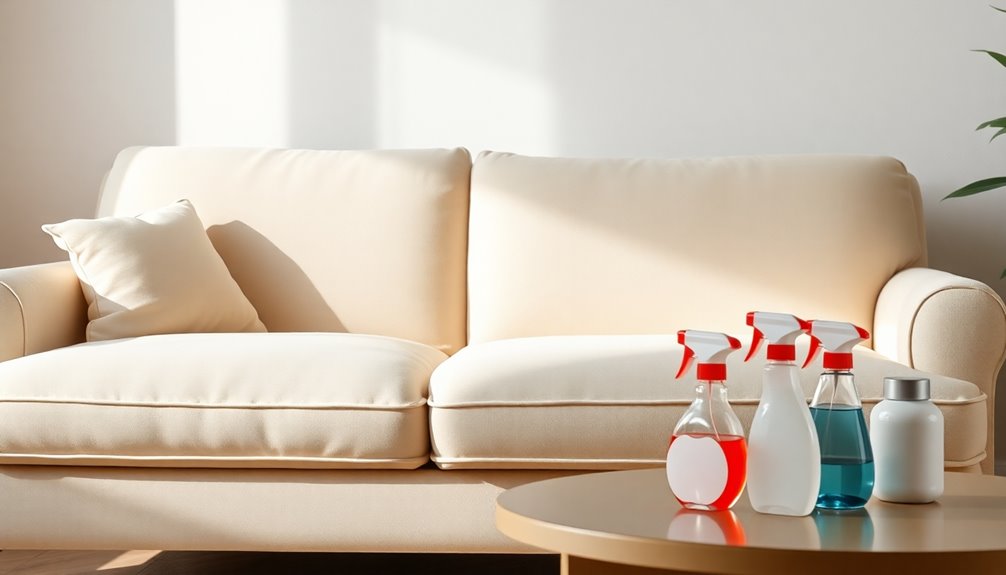
Successfully removing nail polish from your sofa can feel like a daunting task, but with the right approach, it’s manageable. Start by addressing nail polish stains as soon as they happen. Use a clean cloth or paper towel to blot the area, absorbing any excess polish without spreading it further. Next, dampen a cloth with a mixture of liquid dish soap and cool water, then gently blot the stained area until the polish begins to lift. If the stain persists, you can resort to using a small amount of rubbing alcohol or nail polish remover; however, be sure to test these substances on an inconspicuous area first to avoid damaging the fabric. After successfully lifting the stain, rinse the area with clean water and blot dry to prevent any residue. For those also needing to remove paint from wood furniture, a similar blotting technique can be effective, but ensure to use products specifically designed for safe removal to avoid harming the finish.
If you find yourself dealing with stubborn stains, a non-acetone nail polish remover can help. Just remember to apply it to a clean cloth and avoid rubbing the fabric, as this could cause damage. Always conduct a spot test in an inconspicuous area first to check for any discoloration.
If the stain persists or your sofa's fabric is delicate, don't hesitate to seek professional cleaning services. They can provide specialized care that protects your furniture while effectively removing those pesky nail polish stains. With these steps, you can tackle any nail polish mishaps, keeping your sofa looking its best!
Frequently Asked Questions
How to Get Nail Polish Out of Fabric Couch?
To get nail polish out of your fabric couch, start by gently blotting the stain with a clean cloth to absorb excess polish. Mix one tablespoon of dish soap with two cups of cool water, and sponge the stained area while continuing to blot. If needed, apply a small amount of non-acetone remover on a cotton ball, testing it first. Rinse with a damp cloth, blot dry, and let it air dry completely.
Can You Remove Dried Nail Polish From Fabric?
Yes, you can remove dried nail polish from fabric. Start by gently scraping off any hardened polish with a butter knife or toothbrush. Then, apply an ice pack to harden it further. Use a cotton swab dipped in non-acetone nail polish remover to dab at the stain, being careful not to spread it. Finally, blot the area with a cloth soaked in a dish soap and water mixture to lift any remaining residue.
Will Nail Polish Remover Damage a Couch?
Yes, nail polish remover can damage a couch, especially if it contains acetone. This harsh chemical can discolor and deteriorate synthetic fibers, leaving your upholstery looking worse. Even non-acetone removers might cause some discoloration, so it's crucial to conduct a spot test first. If you're unsure, consider using gentler alternatives like dish soap or eco-friendly solutions, or hire a professional cleaning service to protect your valuable furniture.
What Takes Fingernail Polish off of Furniture?
To take fingernail polish off furniture, avoid acetone, as it can harm finishes. Instead, use mineral spirits on a soft rag and gently blot the stain. Always spot test in an inconspicuous area first. If the stain's stubborn, you might try Goo Gone, applying it sparingly. Remember to wipe the area with a damp cloth afterward to remove any cleaning residue. Patience and care will help you restore your furniture's appearance!
